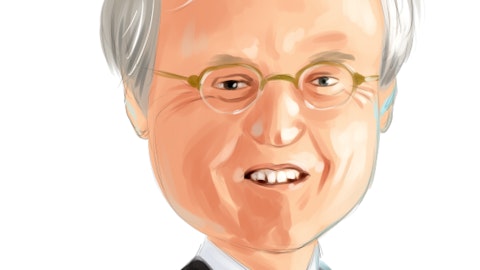David Arcaro: Back on the topic of rate cases, I was just wondering your latest thoughts on the ability to settle rate cases, not for the electric one, obviously, but maybe your gas rate case, and then more broadly going forward in the state for future rate case activity?
Garrick Rochow: We have a historic practice, and we’re coming off a four or five – I have lost track now – settlements. And so, that’s still part of our makeup. We’re still going to look at how to – when a case is underway, how we best reach the right conclusion for our customers and for our investors. And so, we look at those opportunities. I’ve been on these calls before and said, I look for any opportunity for settlement when the conditions are right. But we’re also comfortable going forward because we’re that confident on our ability to get a constructive outcome here in Michigan. This gas case that we filed in December, fairly straightforward. I’m hopeful that we can reach a settlement. Again, if it doesn’t, that’s okay, too. We can get a constructive outcome here in Michigan.
Operator: Next question comes from Michael Sullivan with Wolfe Research.
Michael Sullivan: I know this got asked like a couple different ways, Rejji, but just on the equity needs, maybe if you could just frame how to think about where they could go as CapEx goes higher as we start to roll forward with the REP refresh, like taking into context the ability to use transferability, this cushion you got for Moody’s, like CapEx goes up by x, how much could that potentially increase equity?
Rejji Hayes: I would say, clearly, we’ve made the working assumptions in this current five year plan quite clear, up to $350 million starting in 2025 through the duration of this plan out to 2028. As it pertains to future five year plans, mathematically, I would say yes, if your capital plan increases, and I think based on what we’ve talked about with respect to the prospects in the New Energy Law, we will see upward pressure on our capital plan going forward. Remember, they are sources of offsetting pressure. Given the strength of the regulatory construct in Michigan, there’s very strong operating cash flow generation, which obviously provides a source of internal equity. And then, we’ve got now sources of downward pressure with the ability to monetize tax credits.
The amount we have embedded in our plan is just over $0.5 billion. And I expect that to accrete over time as we take on new renewable projects. And then, obviously, the good news from Moody’s this morning, offers a little bit more headroom on the Moody’s side. Now, I would not suggest at the moment that we’re prepared to give sort of new equity needs on a hypothetical basis, but we’ll recalibrate every year. But I think, again, the strong sources of downward pressure on equity needs will be operating cash flow generation, the ability to monetize credits, and obviously, Moody’s decision today is helpful. And, obviously, we plan conservatively. So that’s the other aspect of it as well. And, obviously, with the great rate construct, in addition to the cash flow generation, we have a solid level of retained earnings, particularly with a very disciplined dividend policy that Garrick highlighted in his prepared remarks.
So that’s the other aspect of that as well.
Michael Sullivan: Just wanted to check in the latest on the [indiscernible] looking at, performance base rates in Michigan, and where that stands and where you potentially see that going.
Garrick Rochow: The process is well underway, Michael, and it’s improving. We’ve seen a move from a handful of metrics down to four metrics that are very benchmarkable across the industry. Our next set of comments are due by February 2. And what we’re leaning into in those comments is a better connection between these outcomes and reliability and more certainty on capital recovery. If you look at best practices for performance based rate making across the country, frankly across the globe, there’s a greater tie between here’s the outcome and here’s the certainty on recovery. So we’re wanting to make sure in our comments that that is true here in Michigan. And so, that’s the work that’s underway. So we’ll continue to follow the process. And I’m sure here, just given the constructive nature of Michigan, we can get to a place, a good landing spot for PBR.
Michael Sullivan: And any sense of just timing on when it could all kind of come to a conclusion?
Garrick Rochow: We’re still in process right now. Like I said, comments are due here February 2. Ideally, here, there’s some milestones around May timeframe as well, but we haven’t got a clear picture on ending perspective. The next electric rate case will be on this one.
Operator: The next question comes from Julien Dumoulin-Smith with Bank of America Merrill Lynch.
Julien Dumoulin-Smith: Maybe zeroing back to where we’ve been talking about the balance sheet here for a little bit. I just want to clarify what’s in the updated CFO, the cash flow number that you projected? I presume that doesn’t include any kind of expectations for uplift on DIG, among other factors. Also, maybe we could talk at the same time about how much additional latitude you’re getting from Moody’s, given the tweak with the juniors there. And then, ultimately, on the dividend, it seems like dividend growth may be slowing a little bit. Should that be the new norm here just given maybe trying to target a lower payout given the accelerated growth?
Rejji Hayes: That’s quite a bit to unpack there. So let me start with DIG and the OCF implications. And so, everything that we’ve highlighted in our five year plan, so think about the rate base growth up to 7.5%, we also talked about additional opportunities attributable to energy efficiency, these are the non-rate base growth drivers of the utility FCM, and then we talked about non-utility opportunities with DIG recontracting, all of that is incorporated into our earnings as well as our cash flow generation. And so, we have a page in the appendix that shows about a little over $13 billion in aggregate cash flow generation over the course of this five year plan, and that incorporates some recontracting that we’ve seen at DIG on both the energy and capacity side, but it does not take into account that open margin that we have on slide 21 in the appendix and the potential opportunities if you see a higher capacity price over time.
And so, there is some upside both from an earnings and cash flow perspective. So not all of that is baked into the cash flow. So there’s additional opportunity there. Just transitioning over to Moody’s, I’ll note that the decision to increase the equity credit from 25% to 50% for junior subordinated notes, that’s worth about 50 to 60 basis points of FFO to debt accretion. And then, with respect to dividend policy, we’ve really been very consistent in dividend policy since we sold EnerBank and started to accelerate the earnings growth of the business. And really, the idea has been to trend down to a low 60s percent payout ratio, as Garrick highlighted in his prepared remarks. And so, what that equates to is really decoupled growth between our DPS growth, our dividend per share growth and our earnings per share growth.
We’ve said 6% to 8% toward the high end earnings per share. We’ll probably be closer to the low end as the $0.11 increase today implies, and that’ll be the plan going forward. Because we do believe that that’s a very efficient use of capital to have the dividend policy in that level, so that we can efficiently fund the growth of the business. And so, really, that’s how we’re thinking about it going forward.



